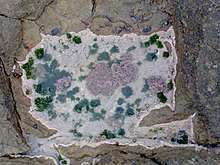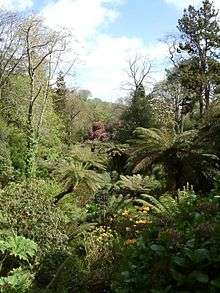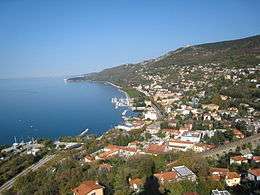Microclimate
A microclimate (or micro-climate) is a local set of atmospheric conditions that differ from those in the surrounding areas, often with a slight difference but sometimes with a substantial one. The term may refer to areas as small as a few square meters or square feet (for example a garden bed or a cave) or as large as many square kilometers or square miles. Because climate is statistical, which implies spatial and temporal variation of the mean values of the describing parameters, within a region there can occur and persist over time sets of statistically distinct conditions, that is, microclimates. Microclimates can be found in most places.

Microclimates exist, for example, near bodies of water which may cool the local atmosphere, or in heavy urban areas where brick, concrete, and asphalt absorb the sun's energy, heat up, and re-radiate that heat to the ambient air: the resulting urban heat island is a kind of microclimate.[1]
Another contributing factor of microclimate is the slope or aspect of an area. South-facing slopes in the Northern Hemisphere and north-facing slopes in the Southern Hemisphere are exposed to more direct sunlight than opposite slopes and are therefore warmer for longer periods of time, giving the slope a warmer microclimate than the areas around the slope. The lowest area of a glen may sometimes frost sooner or harder than a nearby spot uphill, because cold air sinks, a drying breeze may not reach the lowest bottom, and humidity lingers and precipitates, then freezes.
Background


The terminology "micro-climate" first appeared in the 1950s in publications such as Climates in Miniature: A Study of Micro-Climate Environment (Thomas Bedford Franklin, 1955).[2]
The area in a developed industrial park may vary greatly from a wooded park nearby, as natural flora in parks absorb light and heat in leaves that a building roof or parking lot just radiates back into the air. Advocates of solar energy argue that widespread use of solar collection can mitigate overheating of urban environments by absorbing sunlight and putting it to work instead of heating the foreign surface objects.[3]
A microclimate can offer an opportunity as a small growing region for crops that cannot thrive in the broader area; this concept is often used in permaculture practiced in northern temperate climates. Microclimates can be used to the advantage of gardeners who carefully choose and position their plants. Cities often raise the average temperature by zoning, and a sheltered position can reduce the severity of winter. Roof gardening, however, exposes plants to more extreme temperatures in both summer and winter.
In an urban area, tall buildings create their own microclimate, both by overshadowing large areas and by channeling strong winds to ground level. Wind effects around tall buildings are assessed as part of a microclimate study. (Urban Microclimate)
Microclimates can also refer to purpose-made environments, such as those in a room or other enclosure. Microclimates are commonly created and carefully maintained in museum display and storage environments. This can be done using passive methods, such as silica gel, or with active microclimate control devices.
Usually, if the inland areas have a humid continental climate, the coastal areas stay much milder during winter months, in contrast to the hotter summers. This is the case further north on the American west coast, such as in British Columbia, Canada, where Vancouver has an oceanic wet winter with rare frosts, but inland areas that average several degrees warmer in summer have cold and snowy winters.
Soil types
The type of soil found in an area can also affect microclimates. For example, soils heavy in clay can act like pavement, moderating the near ground temperature. On the other hand, if soil has many air pockets, then the heat could be trapped underneath the topsoil, resulting in the increased possibility of frost at ground level.[4]
Sources and influences on microclimate
Two main parameters to define a microclimate within a certain area are temperature and humidity. A source of a drop in temperature and/or humidity can be attributed to different sources or influences. Often microclimate is shaped by a conglomerate of different influences and is a subject of microscale meteorology.
Cold air pool
The well known examples of cold air pool (CAP) effect are Gstettneralm Sinkhole in Austria (lowest recorded temperature −53 °C (−63 °F))[5] and Peter Sinks in the US. The main criterion on the wind speed in order to create a warm air flow penetration into a CAP is the following:
where is the Froude number, — the Brunt–Väisälä frequency, — depth of the valley, and — Froude number at the threshold wind speed.[6]
Craters
The presence of permafrost close to the surface in a crater creates a unique microclimate environment.[7]
Caves and lava tubes
As similar as lava tubes can be to caves which are not formed due to volcanic activity the microclimate within the former is different due to dominant presence of basalt. Lava tubes and basaltic caves are important astrobiological targets on Earth and Mars (see also Martian lava tube).
Plant microclimate
As pointed out by Rudolf Geiger in his book[8] not only climate influences the living plant but the opposite effect of the interaction of plants on their environment can also take place, and is known as plant climate. This effect has important consequences for forests in the midst of a continent; indeed, if forests were not creating their own clouds and water cycle with their efficient evapo-transpiration activity, there would be no forest far away from coasts[9], as statistically, without any other influence, rainfall occurrence would decrease from the coast towards inland. Planting trees to fight drought has also been proposed in the context of afforestation.[10]
Dams
Artificial reservoirs as well as natural ones create microclimates and often influence the macroscopic climate as well.
Cities and regions known for microclimates
Americas
- Northern California above the Bay Area is also well known for microclimates with significant differences of temperatures. The coastline typically averages between 17 and 19 °C (63 and 66 °F) during summer months along that coastline, but inland towns not far from the ocean such as Lakeport, average as much as 34 °C (93 °F) in spite of being just around 40 miles (64 km) inland. Even as far north as the Klamath River valley around the 41st parallel north between Willow Creek and Eureka averages such temperatures, which is extremely hot for such northerly areas. At this parallel, the temperature at the coast is so cool that Willow Creek beats Eureka's all-time record temperature on average 79 times per year. This is in spite of the areas being less than 50 miles from each other. In oceanic stable terms it is like traveling from the summers in the north of England to the south of Spain in a fraction of the distance.
- San Francisco is a city with microclimates and submicroclimates. Due to the city's varied topography and influence from the prevailing summer marine layer, weather conditions can vary by as much as 9 °F (5 °C) from block to block. The Noe Valley district for example, is typically warmer and sunnier than adjacent areas because the surrounding hills block some of the cool fog from the Pacific.
- The region as a whole, known as the San Francisco Bay area can have a wide range of extremes in temperature. In the basins and valleys adjoining the coast, climate is subject to wide variations within short distances as a result of the influence of topography on the circulation of marine air. The San Francisco Bay Area offers many varieties of climate within a few miles. In the Bay area, for example, the average maximum temperature in July is about 64 °F (18 °C) at Half Moon Bay on the coast, 87 °F (31 °C) at Walnut Creek only 25 mi (40 km) inland, and 95 °F (35 °C) at Tracy, just 50 mi (80 km) inland.[11]
- The Los Angeles and San Diego areas are also subject to phenomena typical of a microclimate. The temperatures can vary as much as 18 °F (10 °C)) between inland areas and the coast, with a temperature gradient of over one degree per mile (1.6 km) from the coast inland. Hills and mountains can also block coastal air masses. The San Fernando Valley is usually much warmer in summer than most of Los Angeles, because the Santa Monica Mountains usually block the cool ocean breezes and fog. Southern California has also a weather phenomenon called "June Gloom" or "May Grey", which sometimes gives overcast or foggy skies in the morning at the coast, but usually gives sunny skies by noon, during late spring and early summer.
- The Big Island of Hawaii is also an area known for microclimates, as Kailua-Kona and Hilo, Hawaii experience rainfall of 18 in (460 mm) and 127 in (3,200 mm) per year, respectively, despite being just 60 mi (97 km) from each other.
- Calgary, Alberta is also known for its microclimates. Especially notable are the differences between the downtown and river valley/flood plain regions and the areas to the west and north. This is largely due to an elevation difference within the city's boundaries of over 1,000 ft (300 m), but can also be attributed somewhat, to the effects of the seasonal Chinooks.[12]
- Halifax, Nova Scotia also has numerous microclimates. Coastal temperatures and weather conditions can differ considerably from areas located just 5–15 km (3.1–9.3 mi) inland. This is true in all seasons. Varying elevations are common throughout the city, and it is even possible to experience several microclimates while traveling on a single highway due to these changing elevations.
- Vancouver and its metro area also has many microclimates.[13] North Vancouver and other regions situated on the mountain slopes get over 2,000 millimetres (79 in) of precipitation a year on average, while other regions to the south get around 1,000 millimetres (39 in), although they are less than 40 kilometres (25 mi) away. Temperatures in the Fraser Valley inland may be up to 10 °C (50 °F) warmer than the coast, while in winter they are several degrees colder.
- Chesapeake Bay is also known for its subtropical microclimate.[14] It is most notable for its mild climatic effects on the area east and west of the lowlands of Maryland and Delmarva. Having over 64,000 square miles of water; (most of which is a mix of fresh and salt water) creates higher levels of humidity and heat in the spring and summer months. An example of this effect is the survival of tropical palm trees and plants such as water hyacinths[15] in the area.[16][14]
- Chile Chico and Los Antiguos on the southern shores of General Carrera Lake have favourable conditions for agriculture despite being in inner Patagonia.[17]
Europe
- Known for its wines, the Ticino region in Switzerland benefits from a microclimate in which palm trees and banana trees grow.
- Gran Canaria is called "Miniature Continent" for its rich variety of microclimates.
- Tenerife is known for its wide variety of microclimates.[18]
- Biddulph Grange is very rich with microclimates as a result of the large dips and variety of very large trees alongside a large amount of water.
- Leeds, located in Yorkshire, England is known to have a number of microclimates because of the number of valleys surrounding the city centre.
- The coastal areas in the Andalusia region of Spain has a microclimate. It typically averages around at 30 °C (86 °F) in summer, but Tarifa only averages 24 °C (75 °F). Further north along the coast Cádiz has a summer average of 27 °C (81 °F) withco warm nights, whereas nearby Jerez de la Frontera has summer highs of 33 °C (91 °F) with inland areas further north such as Seville being even hotter.
- Sorana, a commune in Italy's Pescia Valley with a microclimate considered ideal for growing the Sorana bean.[19]
- Barcola near Trieste has been highly valued for its microclimate since ancient times. The shielded location by the sea means that the advantages of the Bora wind, such as liveliness, enterprising spirit and joyous mood, come into play, while at the same time protecting Mediterranean weather.[20]
Asia and Oceania
- Amman, Jordan has extreme examples of microclimate, and almost every neighbourhood exhibits its own weather.[21] It is known among locals that some boroughs such as the northern and western suburbs are among the coldest in the city, and can be experiencing frost or snow whilst other warmer districts such as the city centre can be at much warmer temperatures at the same time.
- Yazd and Kashan in Iran, the traditional architecture benefits from central courtyards with trees and water pools that function together with wind catchers to create a favorable microclimate in this desert area.
- Sydney, Australia has a microclimate occurring prominently in the warmer months. Inland, in Sydney's western suburbs, the climate is drier and significantly hotter with temperatures generally around 3–7 °C (5–13 °F) above Sydney CBD and Eastern Suburbs (the coast), as sea breezes don't penetrate further inland. In summer, the coast averages at 25.9 °C (78.6 °F), while inland varies between 28 and 30 °C (82 and 86 °F), depending on the suburb.[22][23] In extreme occasions, the Coast would have a temperature of 24 °C (75 °F), while a suburb 20 km (12.43 mi)) inland bakes in 36 °C (97 °F) heat. However, winter lows in the West are around 3–5 °C (5–9 °F) cooler than the coastal suburbs, and may provide mild to moderate frost.[24] Within the city and surrounds, rainfall varies, from around 682.5 mm (26.87 in) in the far-west to 1,213.8 mm (47.79 in) at Observatory Hill (the east or the coast).[25]
See also
References
- "6 Examples of an Urban Microclimate". Sotoga.
- Thomas Bedford Franklin (2013). CLIMATES IN MINIATURE: A STUDY OF MICRO-CLIMATE AND ENVIRONMENT. Literary Licensing, LLC. ASIN B00T3N7MTW.
- Pisello, Anna Laura; Saliari, Maria; Vasilakopoulou, Konstantina; Hadad, Shamila; Santamouris, Mattheos (2018). "Facing the urban overheating: Recent developments. Mitigation potential and sensitivity of the main technologies". Wiley Interdisciplinary Reviews: Energy and Environment. 7 (4): e294. doi:10.1002/wene.294. ISSN 2041-840X.
- "Gardening Resources, Cornell University".
- "Mikroklima – Definition – Wissenswertes". www.wetter-freizeit.com.
- J. Racovec et al. Turbulent dissipation of the cold-air pool in a basin: comparison of observed and simulated development. Meteorol. Atmos. Phys. 79, 195–213 (2002).
- "Permafrost in Hawaii, NASA Astrobiology Institute, 2010". Archived from the original on 2014-12-17.
- R. Geiger. The climate near the ground. Harvard University Press, 1957.
- Sheil, Douglas; Murdiyarso, Daniel (2009-04-01). "How Forests Attract Rain: An Examination of a New Hypothesis". BioScience. 59 (4): 341–347. doi:10.1525/bio.2009.59.4.12. ISSN 0006-3568.
- "Make it rain: Planting forests could help drought-stricken regions". CIFOR Forests News. 2012-07-23. Retrieved 2020-02-09.
- "Climate Of California". Wrcc.dri.edu. Western Regional Climate Center. Retrieved 2014-02-02.
- "Calgary's Gardening Climate". Scarboro.ca. 2008-05-05. Retrieved 2014-02-02.
- Kenneth Chan. "Environment Canada splits Metro Vancouver into 5 weather forecast sub-areas". DH News Vancouver. Retrieved March 21, 2020.
- Junko, Morimoto; Helena, Voinov; A., Wilson, Matthew; Robert, Costanza (14 July 2017). "Estimating Watershed Biodiversity: An Empirical Study of the Chesapeake Bay in Maryland, USA". Journal of Geographic Information and Decision Analysis.
- "Learn – University of Maryland Extension". extension.umd.edu.
- "More than Just the Bay".
- Muñoz Rebolledo, M. (2011). Paisajes del agua y trayectorias del arraigo en la Patagonia chilena. CA. Ciudad y arquitectura, (147), 44-49.
- "Tenerife climate: average weather, temperature, precipitation, best time". www.climatestotravel.com. Retrieved 2020-06-09.
- van Caenegem, William; Cleary, Jen (2017-03-27). The importance of place : geographical indications as a tool for local and regional development. Cham, Switzerland. p. 266. ISBN 978-3-319-53073-4. OCLC 980874944.
- Zeno Saracino: “Pompei in miniatura”: la storia di “Vallicula” o Barcola. In: Trieste All News. 29 September 2018; Josef Wasmayer "Wetter- und Meereskunde der Adria" (1976), p 145.
- Potter, Robert B.; Khadija Darmame; Nasim Barham; Stephen Nortcliff (2008). "Ever-growing Amman, Jordan: Urban expansion, social polarisation and contemporary urban planning issues" (PDF). Habitat International. www.journals.elsevier.com/habitat-international. 33: 81–92. doi:10.1016/j.habitatint.2008.05.005. Retrieved 2014-02-02.
- "Sydney/Kingsford-Smith International Airport". Climate statistics for Australian locations. Bureau of Meteorology. Retrieved 27 August 2014.
- "Penrith". Climate statistics for Australian locations. Bureau of Meteorology. Retrieved 19 January 2014.
- "Sydney's Climate". www.livingin-australia.com.
- "Badgerys Creek AWS". Climate statistics for Australian locations. Bureau of Meteorology. Retrieved 19 January 2014.
External links
| Look up microclimate in Wiktionary, the free dictionary. |